Oracle Extractable Value (OEV): The Hidden Revenue and New Frontier in DeFi, In-Depth Research

Gate Ventures
Oracle Extractable Value (OEV) is a subset of Maximal Extractable Value (MEV), OEV represents value that can be extracted when protocols receive updates from price oracles is emerging challenges and significant opportunities in the DeFi ecosystem.
1. Understanding OEV
Definition
OEV is a type of MEV created specifically when protocols receive updates from price oracles. It primarily emerges during liquidation events in lending platforms and arbitrage opportunities in DEXes. Blockchain oracles enable DeFi protocols to calculate the worth of collateral and borrowed assets, or liquidity pool activities, delivering price updates that can trigger event thresholds.
How OEV Works
The OEV general extraction sequence follows:
- Price Update: An oracle (Chainlink, Pyth,…) sends a price update to a DeFi protocol
- Trigger: The update causes event to hit its threshold: liquidation or arbitrage opportunity
- Process: Liquidators repay the debt and claim collateral at a discount (liquidation bonus), whereas arbitrage bot swaps tokens to profit from the price discrepancy
- MEV Extraction: Searchers compete by offering high “bid” to block builders for transaction inclusion
Challenges and Opportunities with OEV
OEV faces several significant issues in the DeFi ecosystem:
- Value Leakage: Major protocols like Aave and Compound have each lost over $100M in value to MEV extractors
- Overpayment for Execution: Lending Protocols pay fixed percentages to incentivize timely liquidations, but significantly overpay when loans are exposed
- Oracle Latency Arbitrage: Perpetual platforms suffer from price discrepancies due to block times and gas fees
- LP Value Extraction: Liquidity providers lose potential arbitrage profits that could otherwise be redistributed
Implementing OEV capture offers multiple advantages:
- New Revenue Streams: Creates sustainable income for protocols previously lost to MEV extractors
- Reduced Penalties: Protocols can potentially reduce liquidation penalties by 5–10%, saving users expend
- Lower Trading Fees: Perpetual protocols can direct arbitrage value back to LPs, enabling fee reductions
- Improved Oracle Performance: OEV-specific auctions can reduce latency impacts
- DeFi Sustainability: Recaptured value maintain operations and increase user incentives
Despite the benefits, still several challenges remain for OEV:
- Oracle Delay: Auction processes can increase update delays, requiring careful adjustment of liquidation bonuses
- Security Concerns: Implementation must not compromise the underlying oracle infrastructure
- Complexity: Application design for MEV capture is difficult, with significant operational method on new layer system as Non-EVM,
- Optimization: Protocols must balance MEV recapture against potential bad debt exposure, bot attacks
2. OEV solution landscape
The Oracle Extractable Value (OEV) ecosystem has evolved rapidly, with several innovative solutions emerging to help protocols recapture this previously lost value. Each solution offers unique approaches, technical architectures, and value propositions. Let’s go these solutions in comprehensive detail:
UMA’s Oval: The Pioneer in OEV Auctions
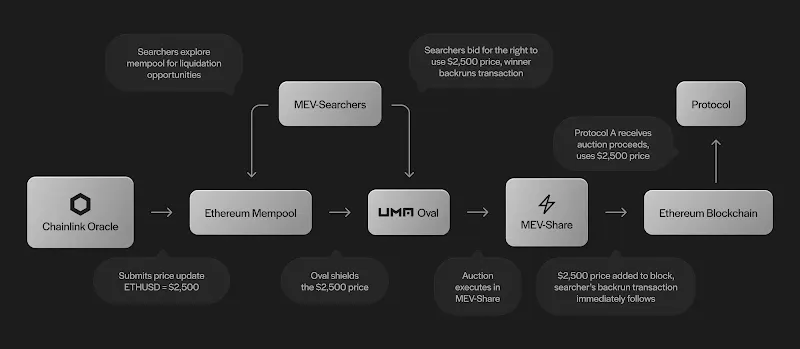
Source: Uma Project
Core Architecture
- Wrapper Design: Oval functions as a wrapper around Chainlink price feeds, intercepting oracle updates before they reach protocols
- MEV-Share Integration: Leverages Flashbots’ MEV-Share infrastructure to conduct sealed-bid auctions for executive rights
- Smart Contract Framework: Implements a two-phase transaction system where winning bidders execute event and return proceeds
Technical Unique Features
- Configurable Auction Parameters: Protocols can adjust auction duration (typically 1–2 blocks) to balance MEV capture against oracle delay risks
- Profit Splitting Mechanism: Implements a dynamic revenue sharing model where 90% of proceeds return to protocols and 10% to infrastructure providers
- Fallback System: Includes automatic failover mechanisms if auctions receive no bids, ensuring oracle updates proceed without disruption
Limitations
- Oracle Specificity: Currently works only with Chainlink price feeds, limiting applicability for protocols using alternative oracles
- Block Time Constraints: Auction efficiency is constrained by Ethereum’s block time, creating latency challenges
- Implementation Complexity: Requires significant protocol-side modifications for integration
Chainlink Smart Value Recapture (SVR): The Risk-Adjusted Approach
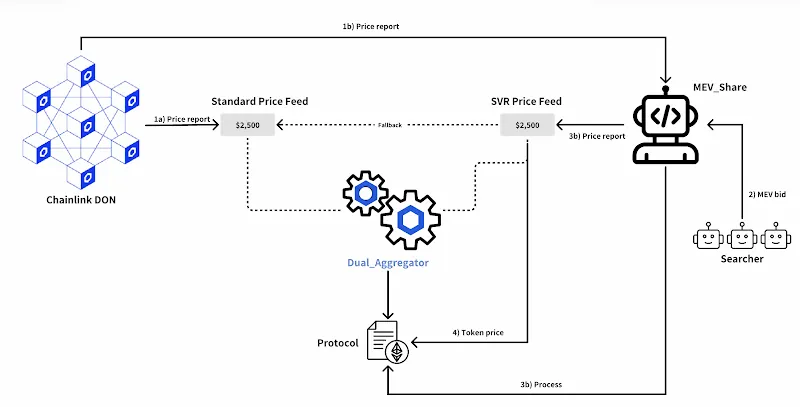
Source: Chainlink & Gate Ventures
Core Architecture
- Dual Aggregator Design: Implements a novel contract architecture with primary and secondary aggregators for enhanced security
- Value-at-Risk Framework: Incorporates sophisticated VaR calculations to dynamically adjust liquidation parameters
- Native Chainlink Integration: Built directly into the Chainlink oracle infrastructure, minimizing integration friction
Technical Unique Features - Risk-Adjusted Liquidation Thresholds: Automatically calibrates liquidation bonuses based on market volatility and position size
- Tiered Auction System: Implements multi-phase auctions with progressively relaxed constraints if initial auctions fail
- Cross-Asset Optimization: Capable of coordinating liquidations across multiple collateral types to maximize efficiency
- Validator Network Participation: Chainlink node operators can optionally participate in validating auction outcomes
Limitations - Oracle Lock-in: Requires protocols to use Chainlink exclusively, limiting multi-oracle strategies
- Computational Overhead: The sophisticated VaR calculations introduce additional computational costs
- Governance Complexity: The numerous configurable parameters create potential governance overhead
API3’s OEV-Share: The Oracle-Centric Approach
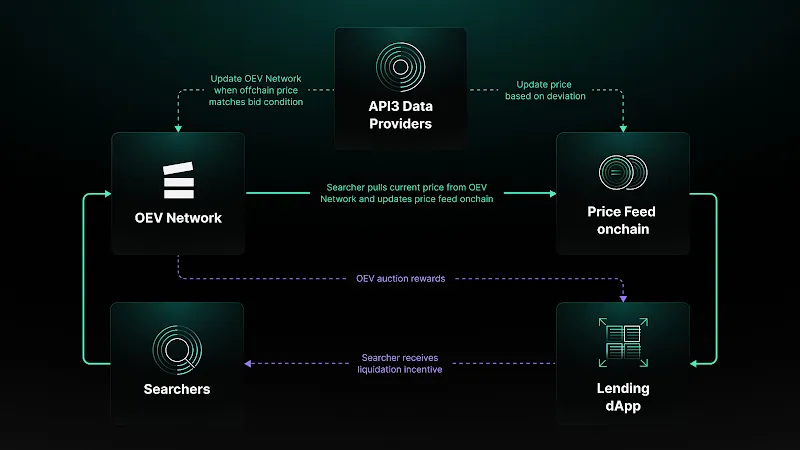
Source: Silo Finance
Core Architecture
- Sidecar Design: Functions alongside existing oracle updates rather than replacing them
- First-Party Oracle Focus: Built specifically for API3’s first-party oracle system, optimizing for direct data source integration
- Exclusive Update Rights: Grants winning auction bidders exclusive rights to trigger oracle updates
Technical Unique Features - Latency Optimization: Reduces transaction delays by up to 40% compared to traditional order flow auctions
- Data Provider Participation: Unique model where original data providers can participate in auction proceeds
- Airnode Integration: Leverages API3’s Airnode infrastructure for secure, decentralized oracle operation
- Cross-Chain Capability: Designed from the ground up to work across multiple blockchain environments
Limitations - Oracle Specificity: Optimized primarily for API3’s oracle network
- Market Penetration: Less widely adopted than Chainlink-based solutions
- Auction Complexity: More complex auction mechanism that may be challenging to optimize
RedStone OEV: The Flexible Hybrid Solution
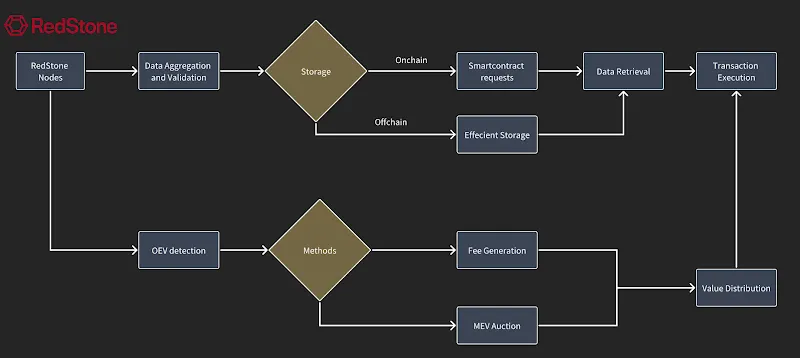
Source: Redstone & Gate Ventures
Core Architecture - Push-Pull Hybrid Model: Combines traditional push-based oracle updates with pull-based auction mechanisms
- Data Delivery Flexibility: Uses RedStone’s innovative data delivery approach that doesn’t require on-chain storage of all price points
- Permissionless Integration: Allows any protocol to integrate without formal partnerships
Technical Unique Features - Adaptive Fee Structure: Implements dynamic fee models based on market conditions and liquidation values
- Direct User Redistribution: Unique capability to redistribute captured OEV directly to affected users
- Multi-Feed Aggregation: Can combine multiple data feeds for more accurate price determination
- Optimized Design: Specifically engineered for efficiency on L2 and Non-EVM with streamlined gas usage
Limitations - Market Adoption: Less established than Chainlink in the oracle marketplace
- Technical Maturity: Newer system with less production testing than alternatives
- Integration Requirements: Requires protocols to adapt to RedStone’s unique data delivery model
Pyth Network’s Oracle OFA: The Centralized Aggregator Approach
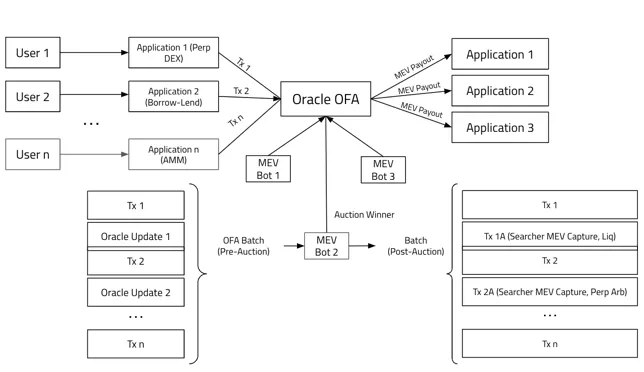
Source: Multicoin Capital
Core Architecture - Global Orderflow Auction (GOFA): Pyth leverages its high-frequency oracle updates to orchestrate a centralized auction framework, aggregating orderflow from multiple applications.
- Oracle-Driven Integration: As a trusted data provider, Pyth naturally commands valuable blockspace around its oracle updates, facilitating a unified auction system.
- Bundled Orderflow: By consolidating orderflows from diverse protocols, Pyth creates deep liquidity pools, enhancing the probability of successful MEV extraction.
Technical Unique Features - Aggregated Liquidity: Combines orderflow across multiple applications to ensure robust and competitive auction dynamics.
- Economies of Scale: The aggregated model drives higher participation from MEV bots due to increased atomic composability, turning fragmented liquidity into a competitive advantage.
- Reduced Operational Overhead: Outsources the auction process to a centralized system, sparing individual protocols from building and maintaining in-house auction mechanisms.
- Revenue Optimization: The centralized auction model enables efficient recapture and redistribution of MEV, directly benefiting both Pyth and its ecosystem participants.
Limitations - Oracle Exclusivity: The system’s efficacy depends on protocols using Pyth’s oracle data, which may limit its application among those preferring alternative oracle networks.
- Scalability Challenges: Managing high-frequency, centralized auctions may introduce scaling and latency issues as participation and orderflow volume increases.
Market Adoption: Broad ecosystem buy-in is essential limited participation could undermine the liquidity benefits of a centralized auction model.
Solution Comparison
When selecting an OEV solution, protocols should consider:
Oracle Dependencies: Which oracle provider is currently in use and migration costs
- Risk Tolerance: Balance between maximizing OEV capture and minimizing oracle delay risks
- Technical Resources: Available development resources for integration
- Protocol Economics: How captured OEV will be distributed (protocol treasury, users, LPs)
- Cross-Chain Strategy: Requirements for multi-chain operation and consistency
Each solution represents a different approach to the OEV challenge, with various levels of specialization, efficiency, and ecosystem integration. The optimal choice depends on a protocol’s specific requirements, existing infrastructure, and strategic priorities in the evolving DeFi landscape.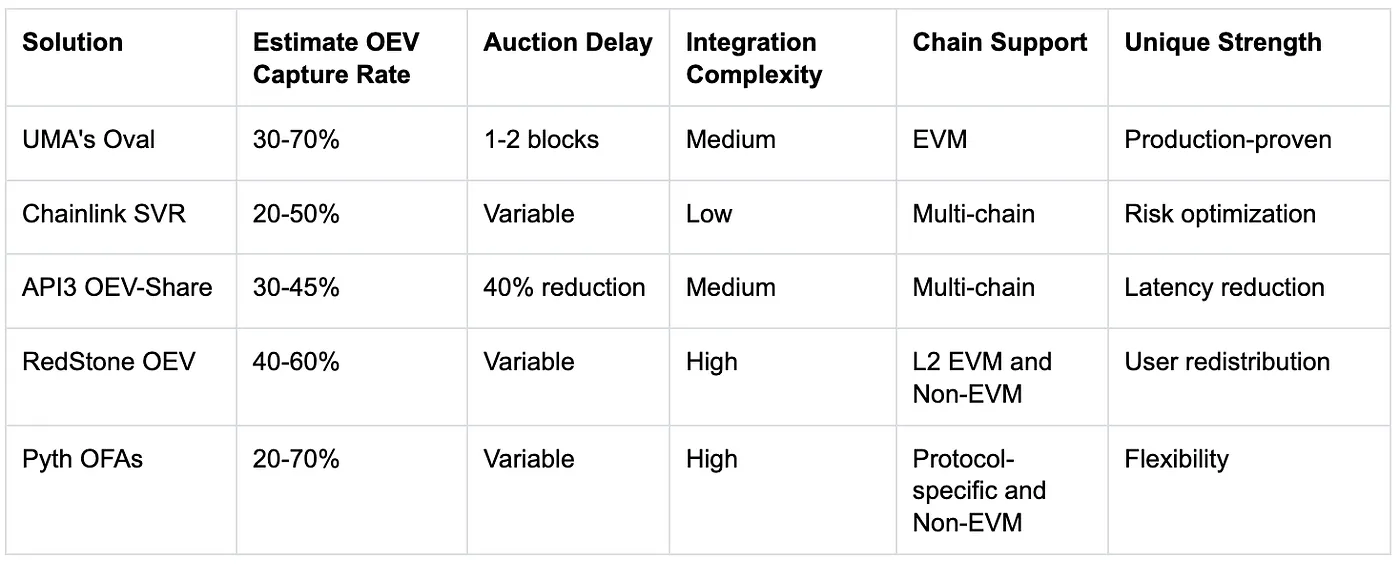
Gate Ventures
Optimized OEV for respective DeFi protocol
Each solution is optimized for the respective protocol, ensuring effective OEV recapture and the generation of revenue streams. Breakdown OEV architecture compatible with protocol mechanisms:
Aave operates as a lending protocol where it requires a mechanism to optimize capital efficiency while capturing additional value from oracle price feeds, especially during liquidations. Chainlink’s SVR, utilizing its “Dual Aggregator” architecture and Flashbots MEV-Share, enables Aave to recapture a significant portion during liquidation events. This recapture value can be redistributed to improve reserve funds, increase APY for lenders, and enhance the protocol’s overall sustainability and competitiveness.
Uniswap V3 (Traditional AMM): as an AMM with concentrated liquidity, OEV has arbitrage opportunities due to price discrepancies when updating oracles. Ideally for Uniswap V3’s rapid trading environment is API3’s OEV-Share. API3’s OEV-Share operates as a sidecar auction, providing fast and efficient data feed updates with reduced latency.
With Uniswap V4 model (Featuring Hook System and Flash Accounting): V4 opens up the possibility of integrating customized logic during swaps. It requires a solution that can be directly embedded within the hook mechanism to adjust fees dynamically. Therefore, RedStone OEV is capable of tapping into external products while creating a native OEV flow, which fits well with V4’s hook system by minimizing latency and facilitating customized trade logic.
Aerodrome ve(3,3) model: This model uses vote-escrow (ve) tokens combined with (3,3) game theory, with the aim of aligned benefit for participants. A solution that effectively recaptures and redistributes it to the protocol is the Chainlink SVR solution, with its “Dual Aggregator” architecture combined with Flashbots MEV-Share, can recapture approximately 20–50% of OEV back to the protocol. This helps increase APY and attract more participants to the Aerodrome ecosystem.
Perpetual DEXes rely heavily on oracles to calculate funding rates and index/mark prices, making them susceptible to liquidation cascades. By that case, UMA’s Oval is designed to execute auctions for MEV recapture by wrapping Chainlink price feeds, redirecting about 90% of the OEV back to the protocol. This is ideal for perpetual DEX environments where price stability and risk mitigation are critical.
Aggregator DEXes, which consolidate orderflow from multiple sources, demand real-time price updates with ultra-low latency to support high-speed trading and maximize MEV opportunities. By Pyth OFAs, they offer continuous and rapid data feed updates with seamless integration, making it an ideal solution for protocols requiring efficient aggregation and processing of diverse orderflows.
In summary, the recommended solutions for each mechanisms are as follows:
- Aave: Chainlink Smart Value Recapture (SVR)
- Uniswap V3: API3’s OEV-Share
- Uniswap V4: RedStone OEV
- Aerodrome: Chainlink Smart Value Recapture (SVR)
- Perpetual DEX: UMA’s Oval
- Aggregator DEX: Pyth OFAs
Conclusion
OEV is no longer just a “bug” in DeFi. It’s developing into a feature for protocol sustain operation. By implementing solutions, protocols can transform MEV from a hidden tax into a revenue engine and it may well become the key of DeFi’s next growth phase.
For investment thesis, addressing the risks while capitalizing on the opportunities, DeFi can turn the OEV challenges into a catalyst for greater efficiency and value retention within the ecosystem. Protocols that prioritize MEV recapture will prove stronger economic models and sustainability in the long term run.
About Gate Ventures
Gate Ventures, the venture capital arm of Gate.io, is focused on investments in decentralized infrastructure, middleware, and applications that will reshape the world in the Web 3.0 age. Working with industry leaders across the globe, Gate Ventures helps promising teams and startups that possess the ideas and capabilities needed to redefine social and financial interactions.
Website: https://www.gate.com/ventures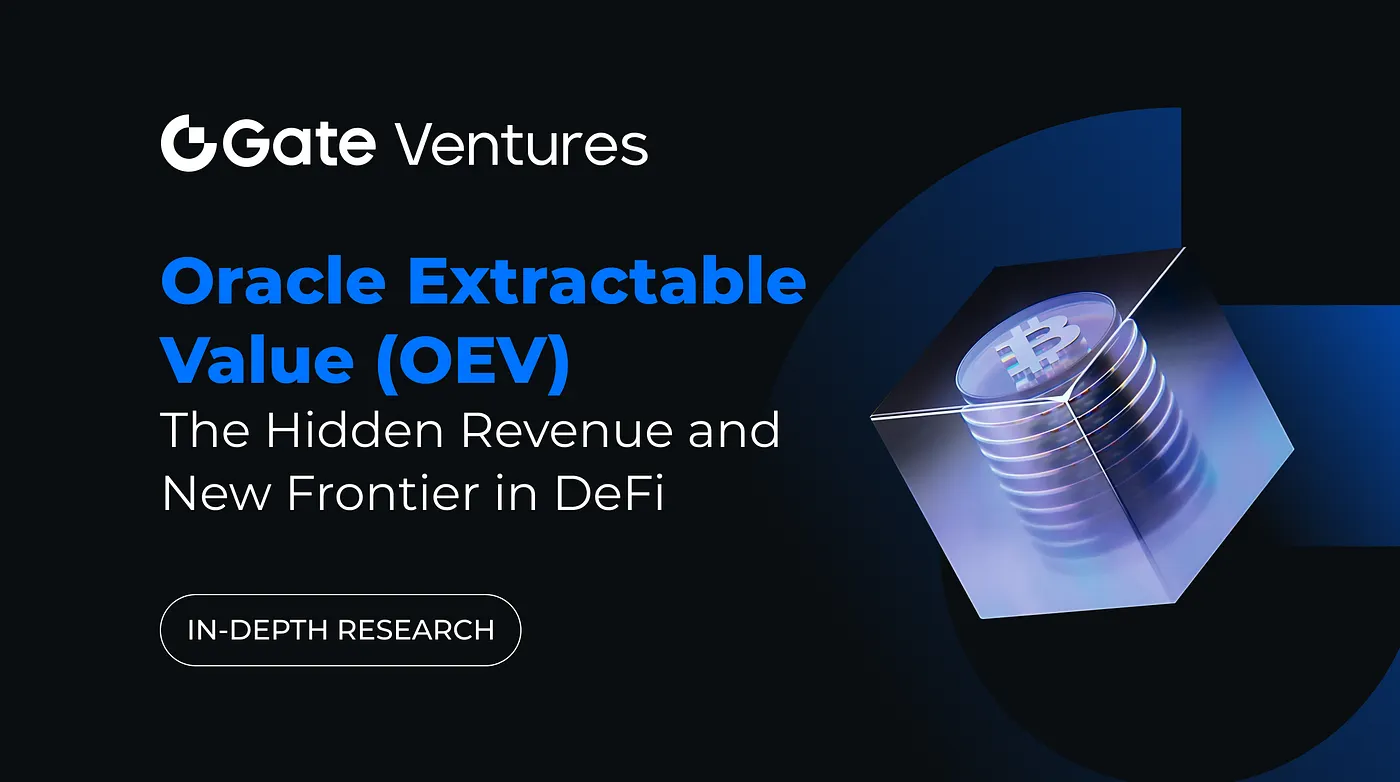
Thanks for your attention.
Share
Content